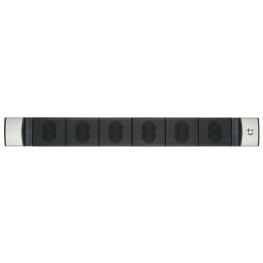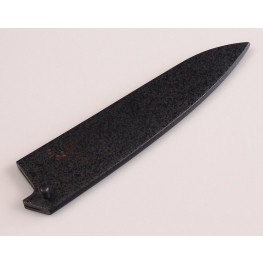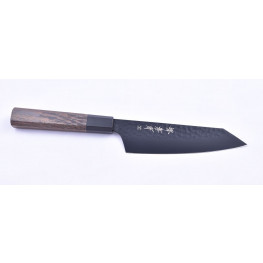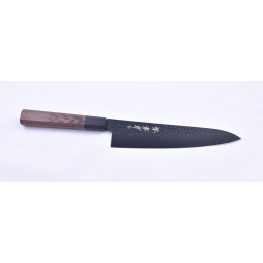Product detail

Sakai Takayuki Kurokage is another great series from the prominent producer Aoki Hamono from the city of Sakai. Its products are sought after primarily by domestic professionals, and obtaining at least a limited amount for export is always a more than difficult task. We are happy to be among the lucky ones who have succeeded.
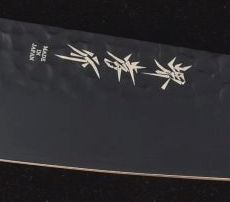
Kurokage is a Japanese term for a black shadow. Looking at the blades of these exotic knives, the reason for the name is immediately clear. Their surface is matte black and the golden kanji characters stand out really well. A careful eye will not miss the gentle hammering in the upper part of the blade. The black coating is not purposeless. It is a Teflon layer which primary role is to reduce friction during cutting. Secondarily, it increases resistance to corrosion, but it is probably unnecessary to talk about the aesthetic benefit. Structurally, it is a typical San Mai, i.e. a hard core clad on each side with one layer of softer steel. In this case, the proven VG10 and SUS410 on the sides were used. The edge is just as interesting as the rest of the blade. It is a typical Hamaguri with a convex shape.
The handle is just as unusual as the blade. Although the octagonal shape is typical for Japanese knives, exotic wenge wood can only be found on the most luxurious ones. This tropical wood is hard, strong and stable. If you add a beautiful brown and black decor, you will understand this choice. Using a ferrule made of any material other than buffalo horn would be a real faux pas in this case.
Sakai Takayuki Kurokage knives have rightfully found their place in our Nippon Knives Top Gun virtual academy.
©2022 Copyright Roman Ulík, Nippon Knives, www.japonskenoze.sk all rights reserved.
Photos and texts are protected by copyright law and their use without the author's consent is not possible.
About producer

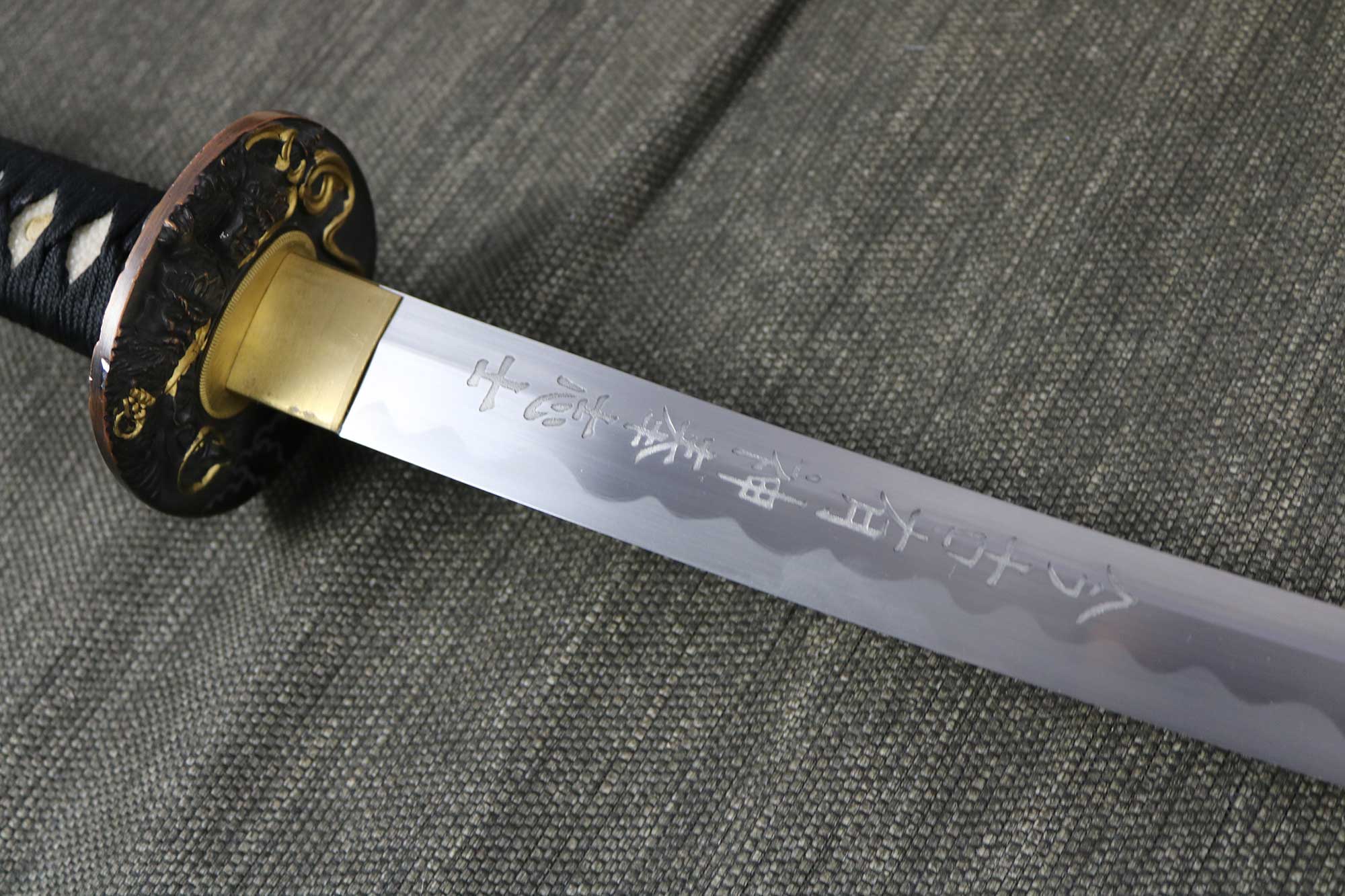
Sword – a symbol of ancient Japan. It is no coincidence that it forms one of the imperial insignia. It is a Kusanagi sword and its core was also created by multiple folding and forging of the highest quality steel. Thanks to many generations of talented craftsmen, this proven method of producing hard and tough material has been preserved to this day. This is how knives were created that have no parallel in the world.
Sakai, or the city of knives, is today a western suburb of Osaka. The city experienced its greatest development in the 16th century, when it was one of the busiest commercial centers. The latest technologies from all over the world as well as different cultures met here. This helped the development of blacksmithing techniques, which had already reached a high level thanks to the production of traditional swords. The Portuguese brought the first rifles to the area and Sakai blacksmiths changed the production program. But since it was a period of peace, they mainly produced decorative rifles. With the boom in tobacco, they smoothly transitioned to the production of knives for cutting tobacco, but the mechanization of its processing resulted in another production change. Blacksmiths began to specialize in the production of kitchen knives. It was also influenced by the proximity of another important city - Kyoto. It is characterized by its culinary art, and the preparation of individual dishes requires special knives. Today, the majority of Japanese chefs use knives made in the city of Sakai.
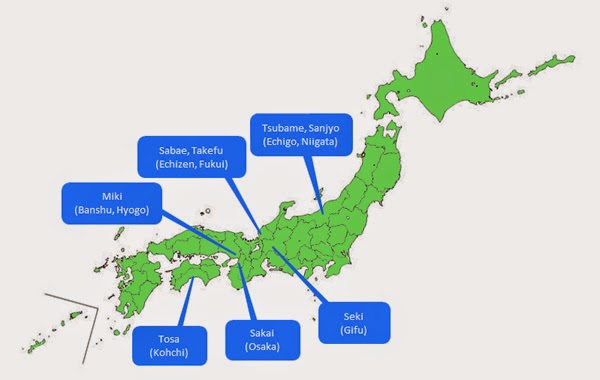

Sakai has a slightly shorter history compared to Seki, but nowadays it is their meaning comparable. The difference is mainly in the production program. In Seki, the production of Western-style Japanese knives prevails, with a strong emphasis on export. Manufacturers in Sakai, on the other hand, specialize mainly in traditional Eastern-type knives. Their clientele consists mainly of Japanese professional chefs.

Mr. Takayuki became famous for consolidating the Sakai blacksmiths in 1946. He provided them with production facilities and tools and thus founded the Sakai Takayuki brand. It is currently being looked after by the 3rd generation of this family. The brand is owned by Aoki Hamono, which in 2006 won the prestigious Sakai Wazashu award for the skill of local manufacturers.
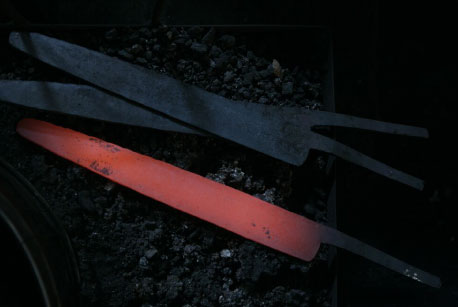
The potential of the Aoki Hamono company lies in key personnel positions, which are blacksmith and grinder. Masters with high awards and with experience exceeding 50 years in some cases work here.
Keijiro Doi - blacksmith
At the age of 19, he took the place of his father, a prominent blacksmith, in the workshop. In 1987, he was certified by the Ministry of International Trade and Industry as a Blacksmith Master. In 1997, he received the Green Paulownia Leaves award.
Yukinori Oda – grinder
He is a holder of the Sacred Treasure order, Silver Rays. Already at the age of 20, he became a master. He sticks to his motto: "The sharpness of a good knife is 100%." However, the role of the grinder is to increase it to 120%."
Suogo Yamatsuka - blacksmith
He constantly pushes the boundaries of perfection. He specializes in Gingami 3 anti-corrosion steel.
Hirotsugu Tosa – grinder
He was born in 1948 and trained as a grinder at the age of 18. In 1991 he achieved the title Sharpener Master. He knows no compromises in his work because he is constantly thinking about the users of his knives.
Itso Doi - Blacksmith
Son of Master Keijiro. It represents the third generation of the clan. He is best placed to preserve this championship for generations to come.
Mitsuo Yamatsuka – grinder
In 1999, he received the Japanese Traditional Craftmanship certificate. It is a guarantee that a traditionally forged knife will acquire "Sakai" sharpness.
Due to the handmade production and the huge interest among professionals in Sakai knives, it is quite difficult to obtain at least a few pieces. Our efforts and patience finally brought us the honor of introducing you to products in which the soul of their makers resides. Welcome to Sakai!
Video from the workshop
©2019 Copyright Roman Ulík, Nippon Knives, www.japonskenoze.sk all rights reserved.
Photos and texts are protected by copyright law and their use without the author's consent is not possible.


 Sign in
Sign in Registration
Registration











